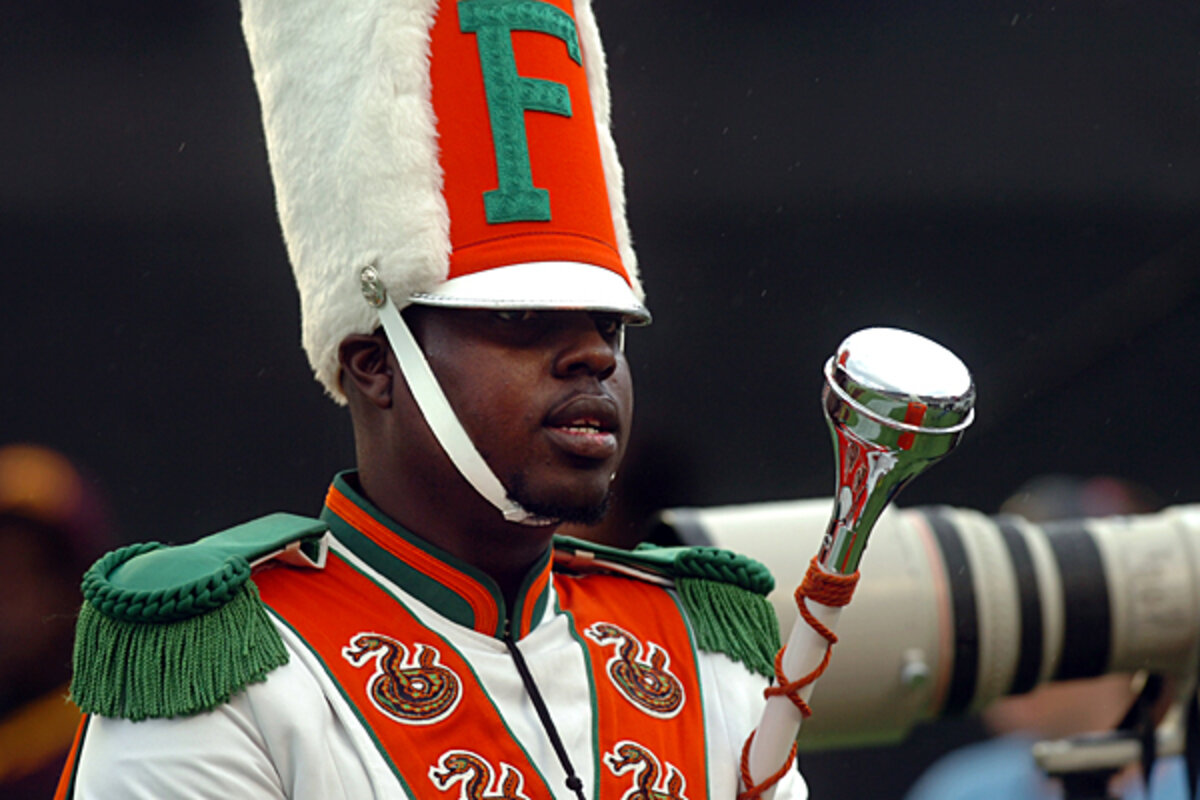Florida A&M hazing: Charges could clip violent traditions
Loading...
| Atlanta
Charges were filed Wednesday against 13 individuals allegedly involved in the hazing death of Florida A&M University drum major Robert Champion last November, raising the stakes for a subculture of violent and clandestine acceptance rituals that remains stubbornly entrenched in many collegial institutions.
Mr. Champion’s death on Nov. 19, 2011, shone a light into a long tradition of hazing at Florida A&M University, a historically black college in Tallahassee whose “Marching 100” band is one of the best in America. A number of students have gotten hurt over the years in rituals that focus on battering and beating members as they run up the aisles of the band’s buses to “get made,” or be accepted.
Champion died after a ritual called “crossing Bus C” in order to be initiated into one of the top rungs of the band’s social hierarchy.
After Champion’s death, FAMU fired, then reinstated, its band director. On Tuesday, it let go two professors who either witnessed or participated in hazing rituals in 2010 without reporting them.
The death has also had broad impact outside Tallahassee. It has prompted leaders of colleges, Greek fraternities, and even the US military to take on rituals that are often defended and protected by students and even some staff as ways to ensure loyalty and inculculate values like respect.
“I hope that people will not see the [charges] today as the final answer, because, yes, there may be individuals who will have to be held responsible and acountable, but I think that we need to take on the challenge that this is a big, broad, serious, even deadly issue, and it involves a lot more people than” those charged on Wednesday, says John Williams, executive director of the Center for the Study of Pan-Hellenic Issues in Tuskegee, Ala., and an expert on hazing at historically black colleges.
On Wednesday, Florida State Attorney Lawson Lamar did not release the names of the suspects, since they were not yet in custody. Eleven of the suspects, said Mr. Lamar, would be charged with hazing with death, a felony that carries up to six years in prison. He called Champion’s death “nothing short of an American tragedy.”
Hazing’s roots go deep, with the first reported incident going back to blacksmithing guilds in AD 381. But the Champion case has brought attention to worrisome trends, experts say: that hazing in some subcultures, like African-American college bands, has arguably become more violent in recent years, and that increasingly sexualized and “abnormal” hazing rituals are being uncovered in US high schools.
“Hazing in most culturally-based organizations is not done for fun, public ridicule or for sport, as we often see in mainstream fraternities and sororities and athletic teams,” writes Michelle Guobadia, director of fraternity and sorority life at the University of North Carolina at Charlotte, on an . “Rather, the continuation of tradition, the earning of respect and honor from others, and a sense of earning the right to be called brother or sister are prevailing themes in why this behavior continues in [black culture]. You won’t find many reports or studies about this because most of us aren’t talking or telling.”
Indeed, because of secrecy around rituals, combating hazing has always been difficult – even though many states, including Florida, have passed laws outlawing the practice.
One problem, says Mr. Williams, has to do with determining when “pledging” to a fraternity crosses over into hazing. Meanwhile, its continued pervasiveness is obvious, even at embattled schools. Two months after Champion’s death, FAMU expelled four students for a hazing-related beating of five clarinet players.
At the same time, however, the FAMU hazing death has drawn an unprecedented response, including from schools with stellar marching bands.
Several high school marching bands were disbanded in DeKalb County, Ga., where Champion was raised, as suspicion rose that some of the hazing culture has its roots in the Atlanta area.
In March, the US Marines tweaked their hazing policy for the first time since 1997, putting more onus on officers to report and stop hazing in the ranks.
In April, Binghamton University in New York shut down all pledging after receiving an “alarming” number of hazing complaints.
And at Tuskegee University in Alabama, another black college, the administration met twice with key stakeholders, including bandleaders, to address hazing in the wake of Champion’s death.
“My sense is there’s a much lower tolerance by most people for [hazing],” Dave Westol, a consultant for national Greek groups, told The Florida Times-Union newspaper recently. “It’s much more in the public eye.”





